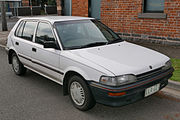
Holden, formerly known as General Motors-Holden, was an Australian subsidiary company of General Motors. Founded in Adelaide, South Australia, it was an automobile manufacturer, importer, and exporter that sold cars under its own marque in Australia. In its last three years, it switched entirely to importing cars. It was headquartered in Port Melbourne, with major industrial operations in the states of South Australia and Victoria. The 164-year-old company ceased trading at the end of 2020.
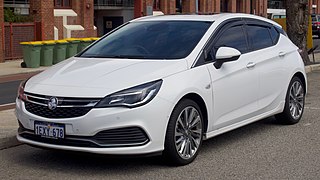
The Holden Astra is a small car formerly marketed by Holden. The first couple of generations of Astra were made only for Australia, and was a derivative of the locally produced Nissan Pulsar. With the Button car plan coming into effect, it was replaced by the Holden Nova, a rebadged Toyota Corolla.
Geo was a brand of small cars marketed by General Motors (GM) as a subdivision of its Chevrolet division from 1989 to 1997.

In the automotive industry, rebadging is a form of market segmentation used by automobile manufacturers around the world. To allow for product differentiation without designing or engineering a new model or brand, a manufacturer creates a distinct automobile by applying a new "badge" or trademark to an existing product line.

The Holden Camira is a mid-size car that was produced by Holden between 1982 and 1989. It was Holden's version of GM's J-body family of cars—GM's third "global" car platform. The name "Camira" comes from an Aboriginal word meaning "wind."

The Toyota Corolla is a series of compact cars manufactured and marketed globally by the Japanese automaker Toyota Motor Corporation. Introduced in 1966, the Corolla was the best-selling car worldwide by 1974 and has been one of the best-selling cars in the world since then. In 1997, the Corolla became the best-selling nameplate in the world, surpassing the Volkswagen Beetle. Toyota reached the milestone of 50 million Corollas sold over twelve generations in 2021.
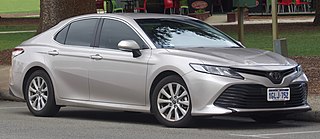
The Toyota Camry is an automobile sold internationally by the Japanese auto manufacturer Toyota since 1982, spanning multiple generations. Originally compact in size (narrow-body), the Camry has grown since the 1990s to fit the mid-size classification (wide-body)—although the two widths co-existed in that decade. Since the release of the wide-bodied versions, Camry has been extolled by Toyota as the firm's second "world car" after the Corolla. As of 2022, the Camry is positioned above the Corolla and below the Avalon or Crown in several markets.

The Holden Apollo was a compact and later mid-size car that was distributed from 1989 to 1997 in Australia by Holden. As a successor to the Holden Camira, the Apollo was a badge engineered version of the Toyota Camry, also sold in Australia. In paralleling two generations of the Camry—the V20 coded as the JK and facelifted JL series Apollo—and the XV10 recoded as the JM and updated JP—there were minor cosmetic differences in the grille, lights and trim.
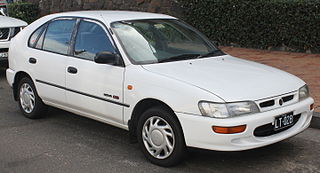
The Holden Nova was a compact car which was manufactured by Toyota Australia as a badge engineered Toyota Corolla between August 1989 and 1996. It was a result of the Button car plan which attempted to rationalise the Australian car manufacturing industry. The Nova was sold and marketed under the Holden nameplate, and although referred to as the GM S platform, was nearly identical to the Corolla. However it received minor stylistic changes. The Nova was sold as a four-door sedan and five-door hatchback.

The Geo Prizm and Chevrolet Prizm were compact cars that were rebadged versions of the Toyota Sprinter, a vehicle that the Japanese automaker Toyota never directly sold in the North American market. The Sprinter itself was derived from the Toyota Corolla. The Prizm was marketed under the Geo nameplate until it was discontinued after the 1997 model year. After that, the vehicle was marketed under the Chevrolet nameplate. General Motors (GM) referred to this and other Toyota Corolla derived vehicles as the GM S platform. The cars were produced from 1988 to 2001 alongside the Corolla at NUMMI, an assembly plant operated as a joint venture of GM and Toyota. The Prizm was sold exclusively in the United States and succeeded the 1985–1988 Chevrolet Nova, which was also derived from the Sprinter and produced at NUMMI.
The Button car plan, also known as the Button plan, was the informal name given to the Motor Industry Development Plan, a Hawke government initiative intended to rationalise the Australian motor vehicle industry and transition it to lower levels of protection. It took its name from Senator John Button, the then federal Minister for Commerce, Trade and Industry.
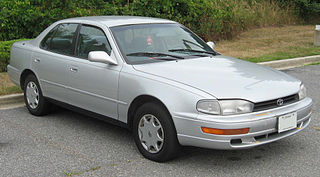
The Toyota Camry (XV10) is a mid-size car that was produced by Toyota between 1991 and 1996 in Japan and North America, and 1993 and 1997 in Australia. The XV10 series represented the third generation of the Toyota Camry in all markets outside Japan, which followed a different generational lineage. The XV10 Camry range is split into different model codes indicative of the engine. Four-cylinder models use the SXV10/SDV10 codes, with VCV10 designating the six-cylinder versions, and MCV10 the later six-cylinder cars in North America only.
Toyota Australia is an Australian subsidiary of the Japanese car manufacturer Toyota. It markets Toyota products and manages motorsport, advertising and business operations for Toyota in Australia. It is also responsible for Lexus vehicles in Australia.
General Motors New Zealand Limited, is a subsidiary of General Motors that distributes GM' motor vehicles, engines, components and parts in New Zealand.

The Holden Commodore (VR) is a full-size car which was produced by Holden from 1993 to 1995. It was the third iteration of the second generation of the Holden Commodore. The VR range included the luxury variants, Holden Commodore Berlina (VR) and Holden Calais (VR) and a commercial model, the Holden Ute (VR).

The Holden Commodore (VS) is a full-size car which was produced by Holden from 1995 to 1997 and 2000 for utility versions. It was the fourth and final iteration of the second generation of the Commodore. The range included the luxury variants, Holden Berlina (VS) and Holden Calais (VS).

The Corolla E90, introduced in 1987 for the 1988 model year, was the sixth generation of cars sold by Toyota under the Corolla nameplate. It was the last generation of Corolla to be classified as a subcompact car and the first to be exclusively front-wheel drive or all-wheel drive; the performance option of rear-wheel drive was dropped.




